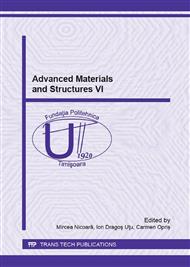[1]
A.A.A. Alghamdi. Collapsible impact energy absorbers: an Overview. Thin-Walled Structures 39 (2001) 189–213.
DOI: 10.1016/s0263-8231(00)00048-3
Google Scholar
[2]
G. Belingardi, A. Scattina. Experimental investigation on the bending behavior of hybrid and steel thin walled box beams – The role of adhesive joints. International Journal of Adhesion & Adhesives 40, 31-37 (2013).
DOI: 10.1016/j.ijadhadh.2012.08.002
Google Scholar
[3]
M. Yamashita, H. Kenmotsu, T. Hattori. Dynamic crush behavior of adhesive-bonded aluminum tubular structure—Experiment and numerical simulation. Thin-WalledStructures69(2013)45–53.
DOI: 10.1016/j.tws.2013.04.005
Google Scholar
[4]
E. Rusi´nskia, A. Kopczy´nski, J. Czmochowski. Tests of thin-walled beams joined by spot welding. Journal of Materials Processing Technology 157–158 (2004) 405–409.
DOI: 10.1016/j.jmatprotec.2004.09.063
Google Scholar
[5]
C. Liu, J.X. Zhang, C.B. Xue. Numerical investigation on residual stress distribution and evolution during multipass narrow gap welding of thick-walled stainless steel pipes. Fusion Engineering and Design 86 (2011) 288–295.
DOI: 10.1016/j.fusengdes.2011.01.116
Google Scholar
[6]
D. Fu, C. Zhou, C. Li, G. Wang, L. Li. Effect of welding sequence on residual stress in thin-walled octagonal pipe−plate structure. Trans. Nonferrous Met. Soc. China 24(2014) 657−664.
DOI: 10.1016/s1003-6326(14)63108-3
Google Scholar
[7]
T. Balawender, T. Sadowski, P. Golewski. Numerical analysis and experiments of the clinch-bonded joint subjected to uniaxial tension. Computational Materials Science 64 (2012) 270–272.
DOI: 10.1016/j.commatsci.2012.05.014
Google Scholar
[8]
T. Balawender, T. Sadowski, P. Golewski. Technological aspects of manufacturing and numerical model ling of clinch-adhesive joint, Springer Brief in Applied Sciences and Technlogy, (2015).
DOI: 10.1007/978-3-319-14902-8_1
Google Scholar
[9]
T. Balawender, T. Sadowski, M. Knec, Technological problems and experimental investigations of hybrid: clinched-adhesively bonded joint", Arch. Metallurgy and Mat. 56 (2011) 439-446.
DOI: 10.2478/v10172-011-0047-3
Google Scholar
[10]
T. Balawender, T. Sadowski, P. Golewski Experimental and numerical analysis of hybrid clinched – adhesive joints. J. Adhesive Sci. and Technology 25 (2011) 2391-2407.
Google Scholar
[11]
Z. Kaifu, C. Hui, L. Yuan. Riveting Process Modeling and Simulating for Deformation Analysis of Aircraft's Thin-walled Sheet-metal Parts. Chinese Journal of Aeronautics 24 (2011) 369-377.
DOI: 10.1016/s1000-9361(11)60044-7
Google Scholar
[12]
J. Min, Y. Li, B.E. Carlson, S Hu, J. Li, J. Linv. A new single-sided blind riveting method for joining dissimilar materials. CIRP Annals - Manufacturing Technology 64 (2015) 13–16.
DOI: 10.1016/j.cirp.2015.04.047
Google Scholar
[13]
T. Sadowski, M. Kneć, P. Golewski. Experimental investigations and numerical modelling of steel adhesive joints reinforced by rivets. International Journal of Adhesion & Adhesives 30, 338-346 (2010).
DOI: 10.1016/j.ijadhadh.2009.11.004
Google Scholar
[14]
T. Sadowski, P. Golewski, M. Kneć. Experimental investigation and numerical modelling of spot welding–adhesive joints response. Composite Structures 112, 66-77 (2014).
DOI: 10.1016/j.compstruct.2014.01.008
Google Scholar
[15]
T. Sadowski, P. Golewski, E. Zarzeka-Raczkowska, Damage and failure processes of hybrid joints: adhesive bonded aluminium plates reinforced by rivets. Comp. Mater. Sci. 50 (2011) 1256-1262.
DOI: 10.1016/j.commatsci.2010.06.022
Google Scholar
[16]
T. Sadowski, M. Kneć. Application of DIC technique for monitoring of deformation process of SPR hybrid joints. Archives of Metallurgy and Materials 58 (2013) 119-125.
DOI: 10.2478/v10172-012-0161-x
Google Scholar
[17]
T. Sadowski, L. Marsavina, Multiscale modelling of Two-phase Ceramic Matrix Composites, Comput. Mat. Sci. 50 (2011) 1336-1346.
DOI: 10.1016/j.commatsci.2010.04.011
Google Scholar
[18]
T. Sadowski, T. Balawender, R. Sliwa, M. Kneć, P. Golewski, Modern hybrid joints in aerospace: modeling and testing, Archives of Metallurgy and Materials 58 (2013) 163-169.
DOI: 10.2478/v10172-012-0168-3
Google Scholar
[19]
T. Sadowski, M. Kneć, P. Golewski, Spot welding-adhesive joints: modelling and testing. J. Adhesion 90 (2014) 346-364.
DOI: 10.1080/00218464.2013.766599
Google Scholar
[20]
E. Postek, T. Sadowski, Assessing the Influence of Porosity in the Deformation of Metal-Ceramic Composites, Composite Interfaces 18 (2011) 57-76.
DOI: 10.1163/092764410x554049
Google Scholar
[21]
Q. Liu, H. Xing, Y. Ju, Z. Ou, Q. Li. Quasi-static axial crushing and transverse bending of double hat shaped CFRP tubes. Composite Structures 117 (2014) 1–11.
DOI: 10.1016/j.compstruct.2014.06.024
Google Scholar
[22]
M. Kotelko, T.H. Lim, J. Rhodes. Post-failure behavior of box section beams under pure bending (an experimental study). Thin-Walled Structures 38, 179-194 (2000).
DOI: 10.1016/s0263-8231(00)00032-x
Google Scholar
[23]
M. Kotełko. Load-capacity estimation and collapse analysis of thin-walled beams and columns – recent advances. Thin-Walled Structures 42, 153-175 (2004).
DOI: 10.1016/s0263-8231(03)00055-7
Google Scholar
[24]
M. Elchalakani. Plastic collapse analysis of CFRP strengthened and rehabilitated degraded steel welded RHS beams subjected to combined bending and bearing. Thin-Walled Structures 82 (2014) 278–295.
DOI: 10.1016/j.tws.2014.05.002
Google Scholar
[25]
Abaqus 6. 11 Analysis User`s Manual. 30. 2. 6 Connector plastic behavior.
Google Scholar
[26]
Abaqus 6. 11 Analysis User`s Manual. 15. 9. 7 Connector section.
Google Scholar
[27]
G. Golewski, P. Golewski, T. Sadowski, Numerical modeling crack propagation under Mode II fracture in plain concretes containing siliceous fly-ash additive using XFEM method, Comput. Mat. Sci. 62 (2012) 75-78.
DOI: 10.1016/j.commatsci.2012.05.009
Google Scholar
[28]
J. Bieniaś, H. Dębski, B. Surowska, T. Sadowski, Analysis of microstructure damage in carbon/epoxy composites using FEM, Comput. Mat. Sci. 64 (2012), 168-172.
DOI: 10.1016/j.commatsci.2012.03.033
Google Scholar


